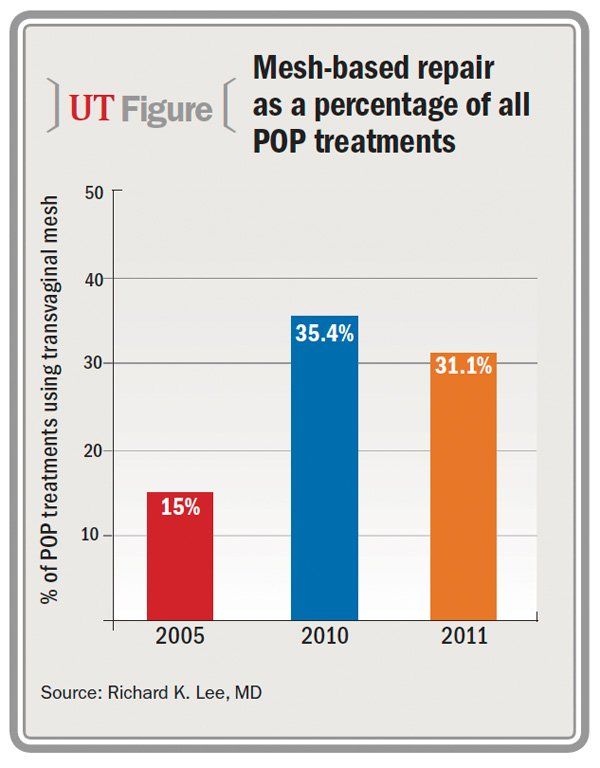Article
Surgical POP treatment rising among older women
The number of older women being diagnosed with and treated for pelvic organ prolapse increased dramatically during the first decade of the 21st century, and surgical interventions gained in dominance. However, while mesh-based transvaginal repair seemed to gain early acceptance, its utilization was impacted by FDA safety notifications about serious mesh-related complications, reported researchers from Weill Cornell Medical College, New York.
Stockholm, Sweden-The number of older women being diagnosed with and treated for pelvic organ prolapse (POP) increased dramatically during the first decade of the 21st century, and surgical interventions gained in dominance. However, while mesh-based transvaginal repair seemed to gain early acceptance, its utilization was impacted by FDA safety notifications about serious mesh-related complications, reported researchers from Weill Cornell Medical College, New York.
Their study findings were presented at the European Association of Urology annual congress in Stockholm, Sweden.
To examine recent nationwide trends in POP diagnosis and treatment among older women, the investigators used data from the 5% Medicare Public Use Outpatient Files from 2001-2011. Patients with a diagnosis of POP were identified using ICD-9 codes, and the method of treatment was determined based on review of CPT codes.
During the 11 years of the study period, the number of women with a diagnosis of POP increased by over 50%, from 68,600 to 104,760, and there was a near quadrupling in the number of women receiving treatment, from 5,420 to 26,540.

Continue to next page for more.
Surgery accounted for the majority of treatment procedures performed in 2001 (52.3%), and its proportion of the total number of treatments increased steadily over time as use of conservative measures (pessaries) decreased. In 2011, surgery accounted for nearly 75% of outpatient interventions for POP, reported senior author Richard K. Lee, MD, assistant professor of urology and public health at Weill Cornell Medical College.
Use of mesh-based transvaginal repair first appeared in 2005, when it already accounted for 15% of all treatments, and that proportion continued to increase over the next several years, reaching a peak in 2010 at 35.4%. However, in 2011, following two FDA safety notifications (2008 and 2011), mesh-based transvaginal repair accounted for only 31.1% of all POP treatments. The data indicated a shift away from mesh-based toward non-mesh-based repairs.
Expect trend to continue
“Our finding that the numbers of older women being diagnosed with and treated for POP are increasing is not surprising considering the growing elderly population. Based on our data and considering the future impact of the aging baby boom generation, urologists may anticipate the number of women seeking care for POP will continue to increase,” said Dr. Lee.
“In addition, they should be aware that while FDA public health notifications resulted in a decline in mesh graft use, women overall seem to be increasingly opting for surgical repair over conservative treatment.”
Dr. Lee noted that three published papers have investigated national trends in POP surgeries with a focus on mesh repairs (Obstet Gynecol 2012; 120:1105-15; Am J Obstet Gynecol 2013; 208:79.e1-7; Neurourol Urodyn 2013; 32:330-5). Compared with the analysis performed by Dr. Lee and colleagues, two of the previous papers used data sources that encompassed a wider age range of patients (≥18 years), and all three covered earlier time periods, ending in 2009 or 2010.
“We chose a Medicare database because POP is a condition affecting predominantly older women and considering the effect the aging baby boom generation is having on the size of the Medicare population,” Dr. Lee said.
“The rising rate of surgical treatment for POP found in our study and the changes in mesh use were also noted in the previous reports. However, our analysis encompasses the most recent data, and so may uniquely capture an impact of the 2011 FDA notification. As new data are released, we will update our analyses to see if the decline in mesh use continues.”UT
Like this article? Check out these other recent Urology Times articles:
Prolapse, SUI treatments found largely equivalent
Colpocleisis found viable for prolapse in older women
Bladder bacteria vary with types of incontinence
Subscribe to Urology Times to get monthly news from the leading news source for urologists.
Newsletter
Stay current with the latest urology news and practice-changing insights — sign up now for the essential updates every urologist needs.















